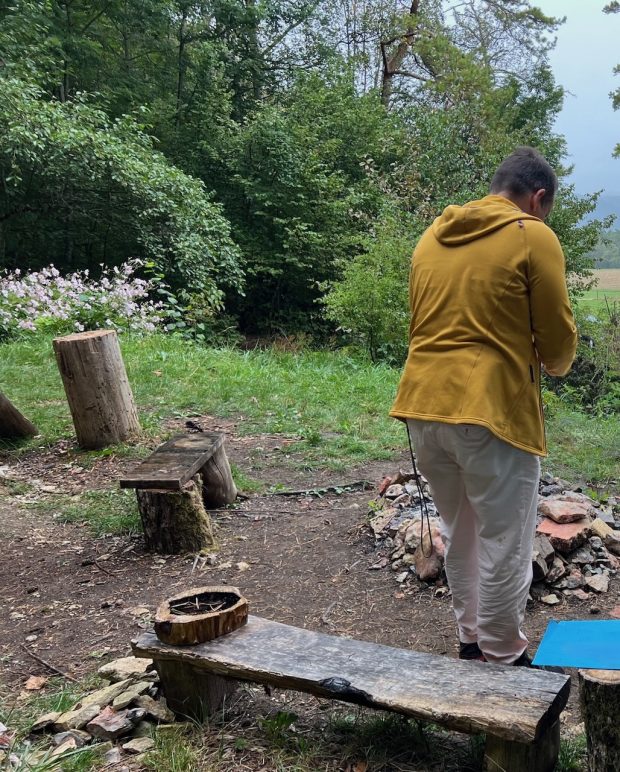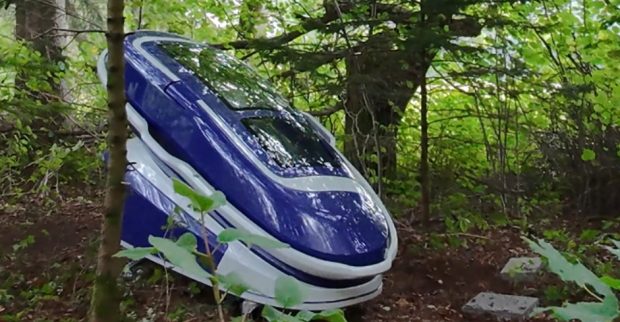June 8, 2025
Was the late Sarco euthanasia assistant Willet wrongfully held in custody in Schaffhausen?
Was the late Sarco euthanasia assistant Willet wrongfully held in custody for too long in Schaffhausen?
Euthanasia assistant Florian Willet helped a woman take her own life using a suicide capsule, came under the scrutiny of the Schaffhausen criminal justice system – and then chose to take his own life.
Now, documents are raising new questions about his pre-trial detention.
It is a gloomy autumn afternoon, 23 September 2024, in Merishausen, which will ultimately cost two people their lives.
A life is planned to end, that of a 64-year-old seriously ill American woman who, on that day in a wooded area in the now famous Sarco, deliberately presses a button to flood the suicide capsule with nitrogen and die from lack of oxygen.
Standing next to her is euthanasia assistant Florian Willet in a yellow windbreaker, recording the woman’s death with his mobile phone, cameras and iPad.
He too will die, the victim of an escalation that no one could have foreseen.
Willet was arrested at the scene, spent 70 days in custody, was released without finding stability, and, as German authorities announced last week, voluntarily took his own life in Cologne on 5 May.

Florian by camp fire, 23 September 2024
The 47-year-old was president of the euthanasia organisation The Last Resort, which wanted to pave the way for self-determined death without medical assistance with the first use of the futuristic capsule in the Schaffhausen forest.
The organisation does not hesitate to assign blame:
Willet was a victim of the justice system, says Philipp Nitschke, the inventor of Sarco, quoting a psychiatric report that diagnosed Willet with an ‘acute polymorphic psychotic disorder’ as a result of the stress caused by his pre-trial detention.
Even if it is too early for such accusations and suicide can rarely be explained by a single cause, everyone who knew Willet says that after his release in December, the highly intelligent, reserved and matter-of-fact man became a paranoid, driven individual, constantly afraid of being bugged and sent back to prison.
How could it have come to this? After all, Willet and the lawyers from his organisation had called the police themselves on that gloomy day on 23 September.

They had documented in detail what had happened and also that suicide in the Sarco was in accordance with the wishes of the seriously ill woman.
While the lawyers and a photographer from the Dutch newspaper Volkskrant who was present were released after 48 hours, Willet remained in custody for 10 weeks.
Documents now indicate that the public prosecutor’s office based its decision on an analysis of the cause of death that subsequently proved to be incorrect.
Only now is it becoming known what the final version of the American autopsy report contains.
A memo dated 24 September from the prosecutor in charge played a decisive role in ordering the remand in custody. In it, she summarises what the Institute of Forensic Medicine in Zurich had told her on the phone about the results of the previous day’s investigation into the death.
It lists in detail all the evidence pointing to ‘compressive blunt force to the neck (strangulation)’.
It mentions ‘pinpoint haemorrhages in the conjunctiva’, signs of blunt force such as bruising at the level of the larynx and a broken left hyoid bone. It states that this was ‘by no means a peaceful death in which the deceased simply fell asleep’.
This file note formed the basis for the subsequent detention request by the Schaffhausen public prosecutor’s office, which, to the astonishment of the lawyers, brought up intentional homicide in addition to aiding and abetting suicide.
The shocking suspicion: the Sarco had not worked properly during its first use, and Willet had helped out.
It is important to note that the public prosecutor’s office had warned Willet and his colleagues in advance that it would open a criminal investigation if they installed the Sarco in Schaffhausen.
However, assisted suicide is only a criminal offence in Switzerland if it is committed for selfish motives.
Willet and the lawyers therefore assumed that, even in the worst case, they would only be detained for a short time.
Only the strong suspicion of intentional homicide combined with the risk of flight allowed the public prosecutor’s office to remand the German, who had only been living in Switzerland for a few years, in custody for 10 weeks.
However, it remained strange that, even in the weeks and months that followed, no actual autopsy report was available apart from this file note.
In a hearing on his release from custody in early November, Willet was only told that his DNA had not been found on the body of the deceased, yet he had to remain in custody.
Officially, the report has only been available since 27 March this year, a full six months after the death at Sarco, as the public prosecutor’s office recently confirmed to the NZZ.
However, according to legal circles, other parties only saw what is allegedly in the nine-page report this week.
The autopsy did not confirm the suspicion of violent external influence, even if it could not be ruled out 100 per cent.
Rather, the marks on the neck that were originally considered suspicious could be explained by natural causes.
This new development does not reflect well on the investigation.
How is such a discrepancy between the telephone memo immediately after the autopsy and the autopsy report possible?
Why did it take so long for the report to be completed?
Why were the accused and their lawyers denied access to it for so long?
And was the long period of pre-trial detention, which ultimately took such a toll on Willet, ordered on the basis of incorrect assessments?
The Schaffhausen public prosecutor’s office is not commenting on these questions ‘due to official and investigative secrecy’.
The chief public prosecutor, Peter Sticher, merely points out that decisions by the coercive measures court, which rules on pre-trial detention, and by the higher court protect the actions of the public prosecutor’s office.
The latter had to rule on an appeal against the refusal to release Willet from custody, but at a time when Willet was already back on the streets, so that the main issue was the costs of the proceedings.
The High Court sided with the investigators.
The problem: in all these decisions, the early telephone memo on the autopsy played a key role, rather than a final report, the findings of which apparently contradicted the memo and were not officially available until later.
Willet and the lawyers involved were therefore surprised about the whereabouts of the autopsy report, which is normally prepared within a few days.
They demanded further access to the files – which the Schaffhausen authorities denied them – and wondered angrily how long the individual steps of the proceedings were taking and whether the public prosecutors were ignoring the camera recordings and oxygen measurements in the capsule that had documented what happened in the forest.
During this entire time, Florian Willet was held in the old, gloomy cantonal prison in Schaffhausen without being questioned even once after the start of his pre-trial detention and without any contact with the outside world except through his two lawyers.
According to them, he coped well during the initial period, but his mental state deteriorated towards the end. On the Saturday before his release, his Schaffhausen lawyer, Urs Späti, had to rush over to calm him down.
‘He was losing his footing, believing that his belongings were being searched,’ says Spaeti.
‘Pre-trial detention is always bad. By definition, you are still innocent, but from one day to the next, you experience the harshest of all prison regimes in isolation.
Being in pre-trial detention for so long was traumatic,’ says Andrea Taormina, the Zurich lawyer representing the Dutch photographer in this case.
Willet was finally released from custody on 2 December – apparently because, after two and a half months, the public prosecutor’s office finally found the oxygen levels measured in the Sarco to be correct, showing that the capsule had not been opened during the assisted suicide.
But by then, the damage had already been done.
According to statements from friends and psychiatric diagnoses, Florian Willet slipped deeper and deeper into a psychotic episode – a diagnosis that describes a sudden mental crisis with severe mood swings and delusions.
In February, he fell from the third floor of his apartment building, which some considered a first suicide attempt, which he denied; he was seriously injured, underwent surgery and had to go into rehabilitation.
Then he disappeared without informing his loved ones. He travelled to Germany to die.
Note – Deepl.com translation